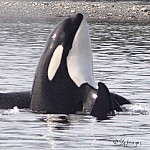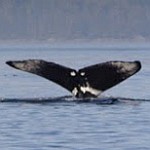The high density of marine traffic in the coastal waters of BC pose a risk to many Cetaceans, as many whales and dolphins spend time at the surface. As a result, Cetaceans can be involved in collisions with fast-moving ships (big and small) leading to injury and possibly death. Many whales and dolphins have scars or severed dorsal fins or pectoral fins, indicating they have been in a collision with boat.
Species that are most often in collisions with vessels are Fin whales and Humpback whales. Collisions have also been reported with other species including Orca and Pacific White-Sided dolphins. Humpback whales and Fin whales are more vulnerable to boat strikes as they take long dives and may surface suddenly in front of boats. They do not echolocate so they may be unaware of vessels approaching them. The survival of the animal depends in part on the speed of the vessel at the time of the collision. At higher speeds such as 20 knots, the force of the impact is greater and will most likely cause a Cetacean to die. At speeds of 10 knots or lower, the Cetacean has a greater chance to survive as the impact is less severe.
Awareness of boat strikes has increased recently. Over the summer of 2017, a dozen of North Atlantic Right whales were found dead along the Eastern coast of Canada and scientists have determined some of them died because of boat strikes. The North Atlantic Right whale population is only approximately 450 so more conservation efforts are being implemented to protect the specie and to decreases chances of boat strikes.
In May 2018, a Humpback whale was observed in Howe Sound (here in B.C.) with a severe gash just behind its dorsal fin on its back, indicating it was in a collision. The Humpback whale was observed and photographed previously the month before without any gash on its back. Because of the boat strike on the Humpback, a warning to boaters was released through the media to be more careful when travelling through areas known to have Cetaceans.
Humpback whale with gash on its back seen in Howe Sound (B.C.), in May 2018.
Photo Credit: Ruana Singh, Steveston Seabreeze Adventures
What can you do?
- Be aware of whale watching guidelines. Stay at least 100 meters away from whales; if observing Southern Resident Orca, stay at least 200 meters away.
- Reduce speed to below 10 knots when in areas where vessel traffic and Cetaceans overlap.
- Travel alternate routes to avoid areas known to have regular Cetaceans.
- Use the Mariners Guide to Whales, Dolphins and Porpoises of Western Canada to reduce your risk of striking and killing or severely injuring marine mammals.



